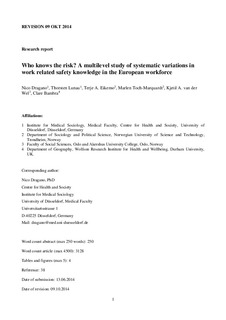| dc.description.abstract | Objectives: Health and safety instructions are important components of occupational prevention. Albeit instruction is mandatory in most countries, research suggests that safety knowledge varies among the workforce. We analysed a large European sample to explore if all subgroups of employees are equally reached. In a comparative perspective, we also investigated if country-level determinants influence the variance of safety knowledge between countries.
Methods: We used data on 24 534 employees from 27 countries who participated in the 2010 European Working Conditions Survey. Safety knowledge was measured as self-assessed quality of safety information. Country-level determinants were added from Eurostat databases (gross domestic product) and the European Survey of Enterprises on New and Emerging Risks (ESENER) study (% companies with A: safety plan or B: a labour inspectorate visit). Associations between knowledge, sociodemographic, occupational characteristics and macrodeterminants were studied with hierarchical regression models.
Results: In our sample, 10.1% reported a low degree of health and safety knowledge. Across all countries, younger workers, lower educated workers, production workers, private sector employees, those with less job experience or a temporary contract, or those who work in small businesses were more likely to report low levels of information. Moreover, low information prevalence varied by country. Countries with a high proportion of companies with a safety plan and recent labour inspectorate on-site visits had higher proportions of informed workers.
Conclusions: A vast majority reported to be well informed about safety risks but systematic inequalities in the degree of knowledge between subgroups were evident. Further efforts on the workplace, the organisational and the political level are needed to universally implement existing occupational safety regulations. | nb_NO |
